Honor Award
What’s Out There
The Cultural Landscape Foundation
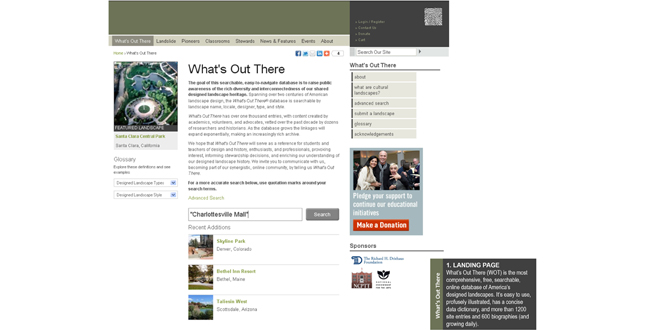 Close Me!
Close Me!Landing Page. What’s Out There (WOT) is the most comprehensive, free, searchable, online database of America’s designed landscapes. It’s easy to use, profusely illustrated, has a concise data dictionary, and more than 1200 site entries and 600 biographies (and growing daily).
Download Hi-Res ImageImage: The Cultural Landscape Foundation
Image 1 of 14
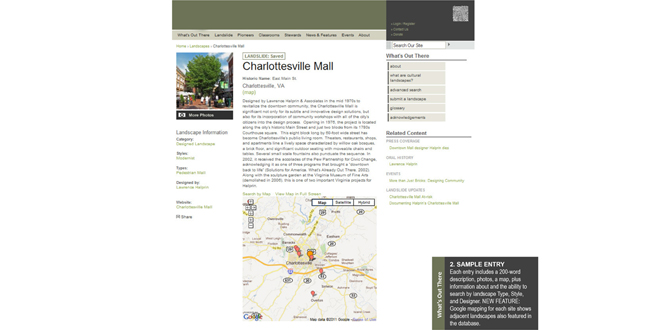 Close Me!
Close Me!Sample Entry. Each entry includes a 200-word description, photos, a map, plus information about and the ability to search by landscape Type, Style, and Designer. NEW FEATURE: Google mapping for each site shows adjacent landscapes also featured in the database.
Download Hi-Res ImageImage: The Cultural Landscape Foundation
Image 2 of 14
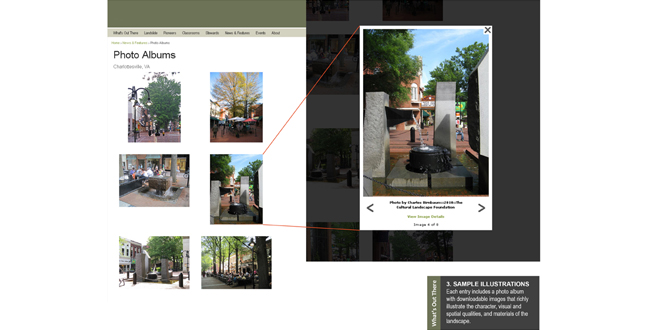 Close Me!
Close Me!Sample Illustrations. Each entry includes a photo album with downloadable images that richly illustrate the character, visual and spatial qualities, and materials of the landscape.
Download Hi-Res ImageImage: The Cultural Landscape Foundation
Image 3 of 14
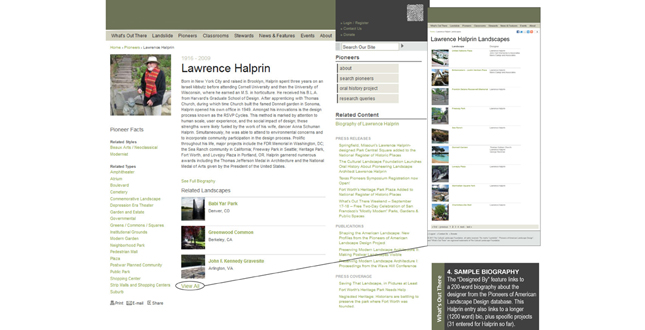 Close Me!
Close Me!Sample Biography.The “Designed By” feature links to a 200-word biography about the designer from the Pioneers of American Landscape Design database. This Halprin entry also links to a longer (1200 word) bio, plus specific projects (31 entered for Halprin so far).
Download Hi-Res ImageImage: The Cultural Landscape Foundation
Image 4 of 14
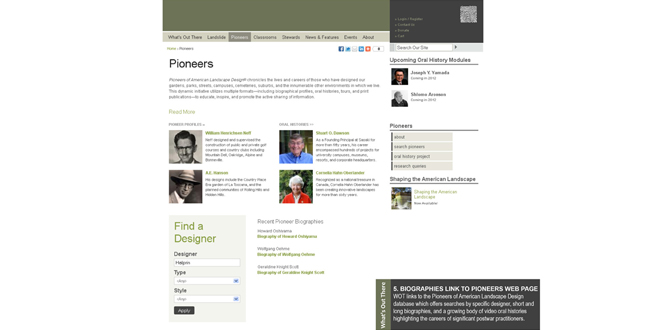 Close Me!
Close Me!Biographies Link to Pioneers Web Page.WOT links to the Pioneers of American Landscape Design database which offers searches by specific designer, short and long biographies, and a growing body of video oral histories highlighting the careers of significant postwar practitioners.
Download Hi-Res ImageImage: The Cultural Landscape Foundation
Image 5 of 14
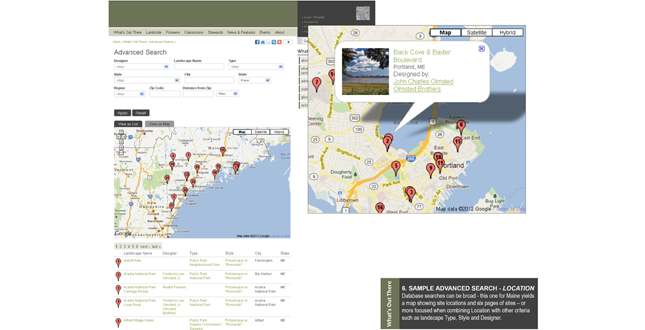 Close Me!
Close Me!Sample Advanced Search — Location. Database searches can be broad - this one for Maine yields a map showing site locations and six pages of sites – or more focused when combining Location with other criteria such as landscape Type, Style and Designer.
Download Hi-Res ImageImage: The Cultural Landscape Foundation
Image 6 of 14
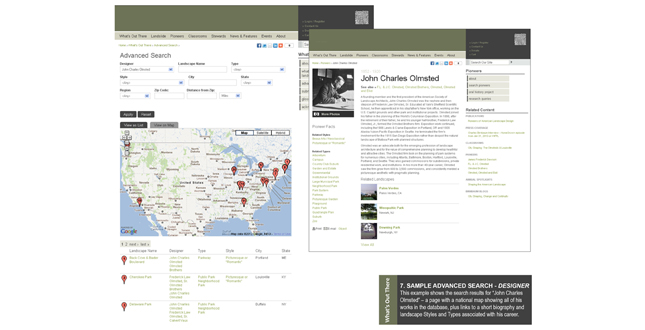 Close Me!
Close Me!Sample Advanced Search — Designer. This example shows the search results for “John Charles Olmsted” – a page with a national map showing all of his works in the database, plus links to a short biography and landscape Styles and Types associated with his career.
Download Hi-Res ImageImage: The Cultural Landscape Foundation
Image 7 of 14
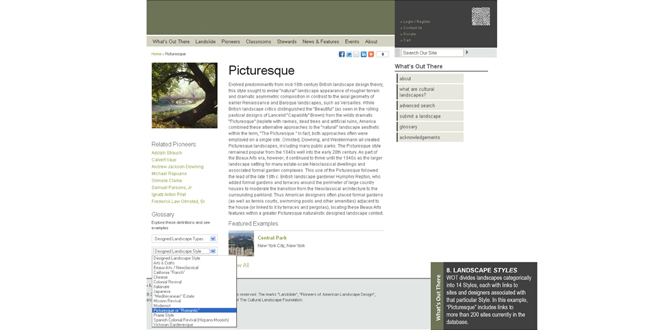 Close Me!
Close Me!Landscape Styles. WOT divides landscapes categorically into 14 Styles, each with links to sites and designers associated with that particular Style. In this example, “Picturesque” includes links to more than 200 sites currently in the database.
Download Hi-Res ImageImage: The Cultural Landscape Foundation
Image 8 of 14
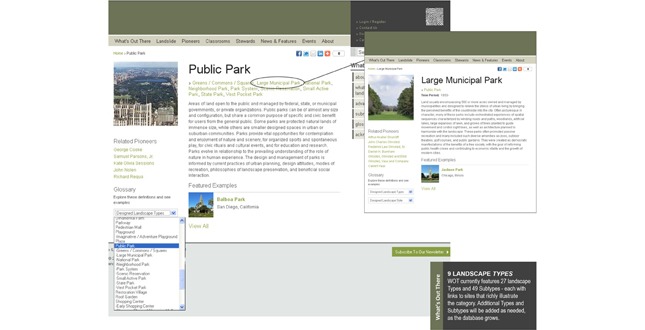 Close Me!
Close Me!Landscape Types. WOT currently features 27 landscape Types and 49 Subtypes — each with links to sites that richly illustrate the category. Additional Types and Subtypes will be added as needed, as the database grows.
Download Hi-Res ImageImage: The Cultural Landscape Foundation
Image 9 of 14
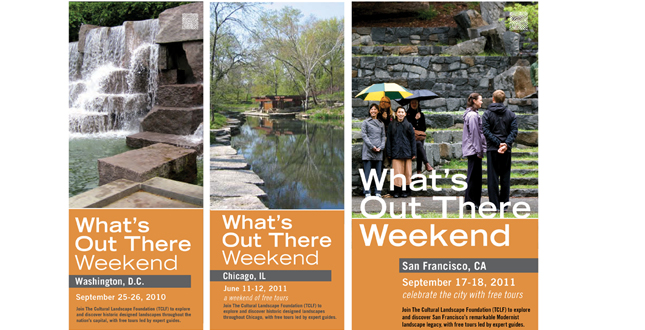 Close Me!
Close Me!What's Out There Hits the Streets. What’s Out There Weekends take the discovery of landscape design from the desktop to the street with free, expert-led tours of sites in the database – thousands have attended in DC, Chicago & San Francisco.
Download Hi-Res ImageImage: The Cultural Landscape Foundation
Image 10 of 14
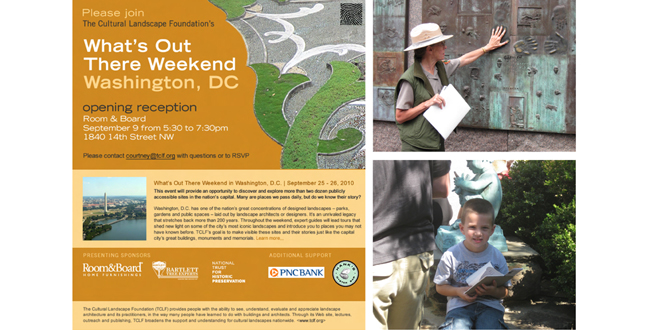 Close Me!
Close Me!Inaugural What's Out There Weekend — Washington, DC. The inaugural weekend set the series tone– a mix of tours of iconic sites on or near the National Mall with lesser-known local parks, gardens and public spaces within the national capital’s neighborhoods.
Download Hi-Res ImageImage: The Cultural Landscape Foundation
Image 11 of 14
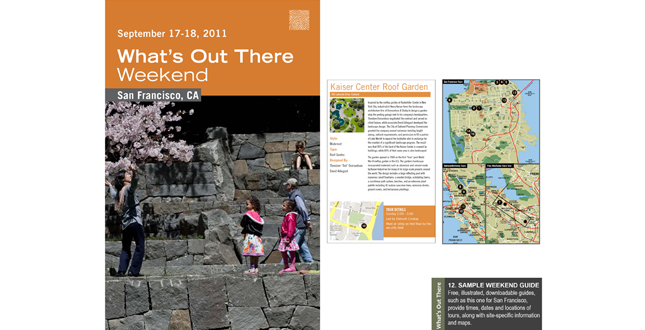 Close Me!
Close Me!Sample Weekend Guide. Free, illustrated, downloadable guides, such as this one for San Francisco, provide times, dates and locations of tours, along with site-specific information and maps.
Download Hi-Res ImageImage: The Cultural Landscape Foundation
Image 12 of 14
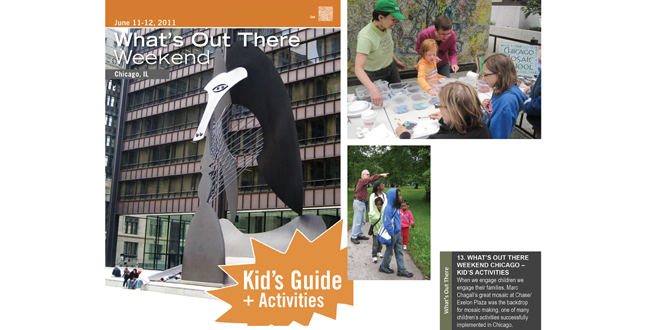 Close Me!
Close Me!What's Out There Weekend Chicago — Kid's Activites. When we engage children we engage their families. Marc Chagall’s great mosaic at Chase/Exelon Plaza was the backdrop for mosaic making, one of many children’s activities successfully implemented in Chicago.
Download Hi-Res ImageImage: The Cultural Landscape Foundation
Image 13 of 14
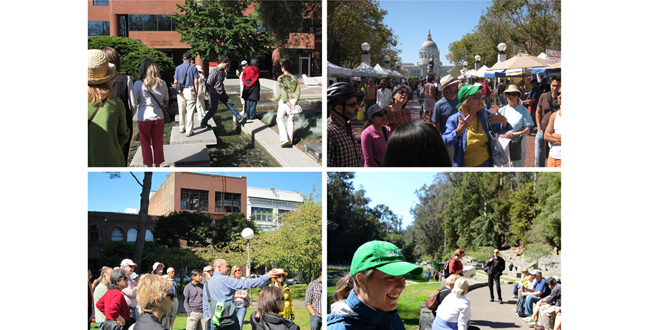 Close Me!
Close Me!What's Out There Weekends are Popular. Families, landscape aficionados, neighborhood activists, and numerous others have attended, with many tours oversubscribed. Participants may see these sites daily, but often learn about them for the first time during What’s Out There Weekend.
Download Hi-Res ImageImage: The Cultural Landscape Foundation
Image 14 of 14
Project Statement
What’s Out There (WOT) is the most comprehensive, free, illustrated, searchable online database of America’s designed landscapes. WOT’s goal is to make the rich diversity and interconnectedness of our shared landscape heritage visible and valued. Launched in October 2009, and recipient of NEA, NCPTT, and Driehaus Foundation grants, WOT currently spans three centuries of landscape design with more than 1200 vetted site descriptions, 600 designer profiles, thousands of images, a detailed glossary, maps, and more.
Project Narrative
—2012 Professional Awards Jury
What’s Out There (WOT) is the most comprehensive, vetted, free, illustrated, searchable online database of America’s designed landscapes. The site launched in October 2009 after ten years in development, and has twice been funded by both the National Endowment for the Arts (NEA) and the Richard H. Driehaus Foundation, along with the National Center for Preservation Technology and Training (NCPTT); additional support comes from corporate and private giving.
WOT serves multiple functions and reaches many audiences; most importantly, WOT is a centralized starting point for professionals and practitioners, students and scholars to explore, research, understand and appreciate the interconnection and complexity of our shared landscape heritage. WOT is also being utilized by heritage travelers, gardeners and landscape enthusiasts to understand the designed landscape legacy in their own neighborhoods and across the country. In addition, WOT aids in the public planning process by providing information and context that helps guide change and intervention.
Central to WOT is a concise yet comprehensive glossary organized under 27 types (e.g. Park), 49 sub-types (e.g. Vest Pocket Park) and 14 styles (e.g. Modernist). Written by leading scholars and academics, these categories are presented as drop-down menus, which along with the name of the designer and the location, allow visitors to frame individual research queries.
The database also includes more than 600 designer profiles, each with 200-word essays and many with additional, more extensive 1000-word biographies. The designer profiles are complemented by the organization’s publications, Pioneers of the American Landscape (2000) and Shaping of the American Landscape (2009), which contain longer profiles, and a free, online oral history series featuring a select group of influential postwar practitioners.
WOT contains more than 1200 site entries, cataloging some of America’s most important designed landscapes from the 17th century to 1976, along with some post-Bicentennial works of landscape architecture designed by practitioners whose careers have been realized. There are historic designed landscapes from all 50 states, National Historic Landmark (NHL) properties designated with significance in landscape, and some of the approximately 1900 National Register of Historic Places sites that include designed landscapes. These site entries are profusely illustrated with current photography and include a concise site description and relevant links to styles, types, designer biographies, related Web sites, and other supporting materials.
Based on targeted evaluation and outreach done to date, we know a broad audience accesses the database. WOT serves as a design and history reference for middle, high school, and college students and their teachers; history, landscape, and garden enthusiasts; and landscape professionals including students of landscape architecture. The database provokes interest, informs stewardship decisions, and enriches the understanding of our shared designed landscape history.
A relatively new programmatic outgrowth of the database, What’s Out There Weekend, features free, expert-led tours of publicly accessible designed landscapes. Serving several thousand attendees, What’s Out There Weekend has been held in Chicago, San Francisco and Washington, DC, with upcoming tours scheduled for New York City and other locations. What’s Out There Weekend helps foster a stewardship ethic by giving people the opportunity to experience anew the public parks, gardens, plazas, cemeteries, memorials, and neighborhoods they may see every day but don’t necessarily know about.
The WOT database continues to grow richer each day thanks to an ongoing interaction with its audience and a series of carefully constructed partnerships with professional colleagues, like-minded institutions, and university-based landscape architecture and planning programs. The university partnerships offer a particularly rich way of interacting and encouraging future stewardship. Supportive faculty have incorporated WOT content creation into their classroom curriculum, which has expanded the database significantly in particular parts of the country. For example, our partnership with Louisiana State University has yielded some 50 new WOT entries in the area, and we expect similar results in 2012 from our partnership with the University of Washington. Through a partnership with the Maine Historical Society supported by a grant from the NEA, the WOT database has recently gained more than 150 Maine landscapes.
What’s Out There offers a unique window into America’s landscape history. As the database grows linkages between sites, designers, types and styles will expand exponentially, making an increasingly rich archive and leading to ever-greater stewardship of our shared designed landscape heritage.
Project Resources






